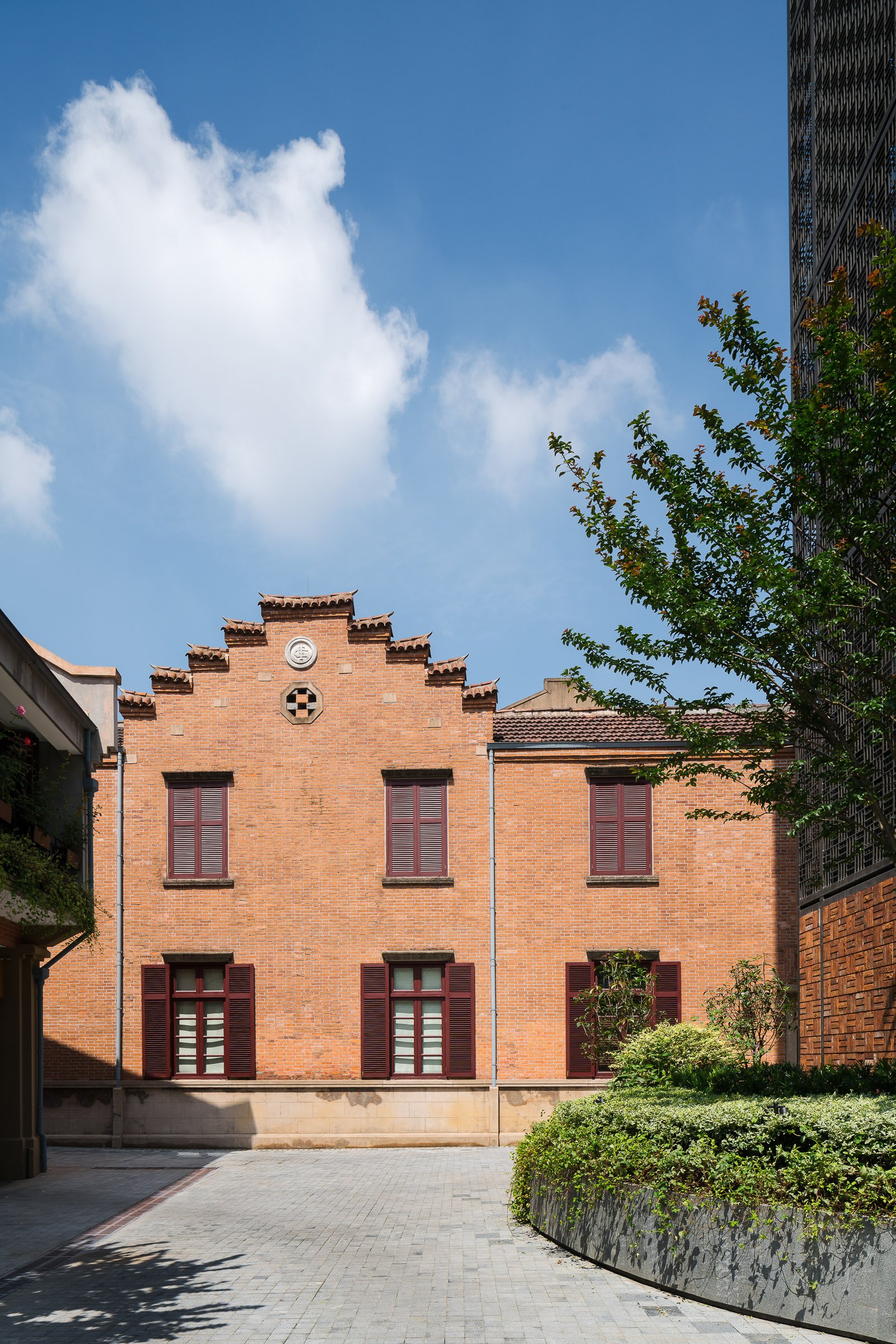
Originally built in the 1930s by French real estate company Foncière et Immobilière de Chine, the Jian Ye Li “shikumen” complex; located in the heart of the former French concession had evolved and been altered over the years but was essentially intact in its historical configuration and represented an incredible development opportunity.
Originally these “shikumen” buildings were designed for middle class families in Shanghai and as they lacked modern plumbing facilities they were often seen as products with little value to preserve and were either demolished or just the “shell” was maintained and they were converted it into commercial use. After extensive research and study, Kokaistudios developed an architectural renovation strategy that maintained the architectural features of the “shikumen” lane houses while tastefully altering the internal layout and transforming them into spaces suitable for modern luxurious living where each original lane house unit was transformed into one luxurious guest suite.
Practicality is not a term that applies to this project as the shikumen architectural typology; characterized by their narrow and tall nature meaning that the minimum 110 sq.m suites are split over 2 floors via a step staircase with no elevator; does not lend itself naturally to conversion to hospitality use. However when the ultra-luxury Capella hotel brand entered into the project several years later minimal upgrades to the architecture of the buildings were required to meet their exacting standards and they created 55 luxury suites each occupying one of the lane-houses.
Today the hotel occupies a unique position within Shanghai’s luxury hotel landscape and offer their guests a truly unique hospitality experience not available anywhere else in the world.
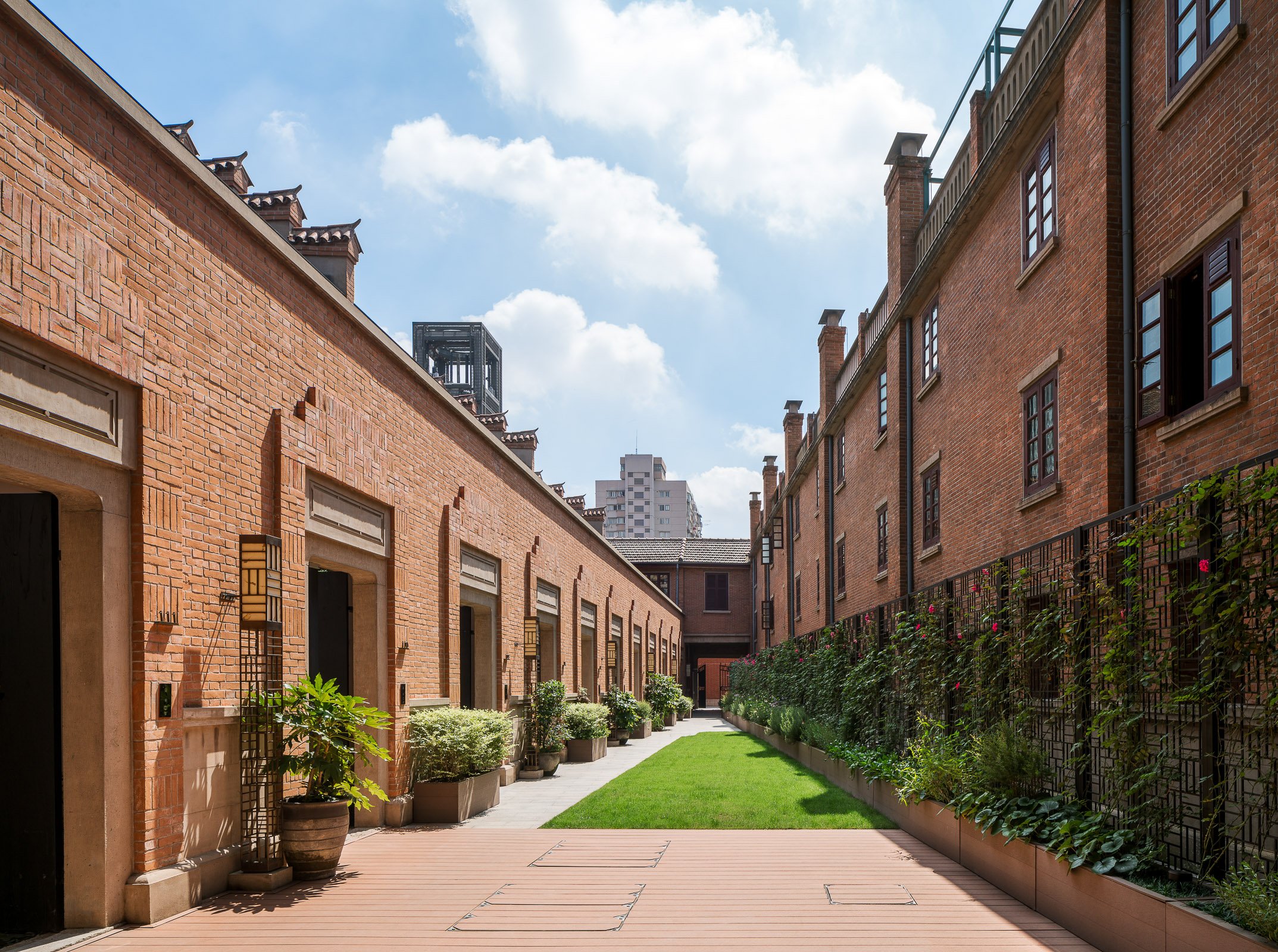
Originally built in the 1930s by French real estate company Foncière et Immobilière de Chine, the Jian Ye Li “shikumen” complex; located in the heart of the former French concession had evolved and been altered over the years but was essentially intact in its historical configuration and represented an incredible development opportunity.
Originally these “shikumen” buildings were designed for middle class families in Shanghai and as they lacked modern plumbing facilities they were often seen as products with little value to preserve and were either demolished or just the “shell” was maintained and they were converted it into commercial use. After extensive research and study, Kokaistudios developed an architectural renovation strategy that maintained the architectural features of the “shikumen” lane houses while tastefully altering the internal layout and transforming them into spaces suitable for modern luxurious living where each original lane house unit was transformed into one luxurious guest suite.
Practicality is not a term that applies to this project as the shikumen architectural typology; characterized by their narrow and tall nature meaning that the minimum 110 sq.m suites are split over 2 floors via a step staircase with no elevator; does not lend itself naturally to conversion to hospitality use. However when the ultra-luxury Capella hotel brand entered into the project several years later minimal upgrades to the architecture of the buildings were required to meet their exacting standards and they created 55 luxury suites each occupying one of the lane-houses.
Today the hotel occupies a unique position within Shanghai’s luxury hotel landscape and offer their guests a truly unique hospitality experience not available anywhere else in the world.
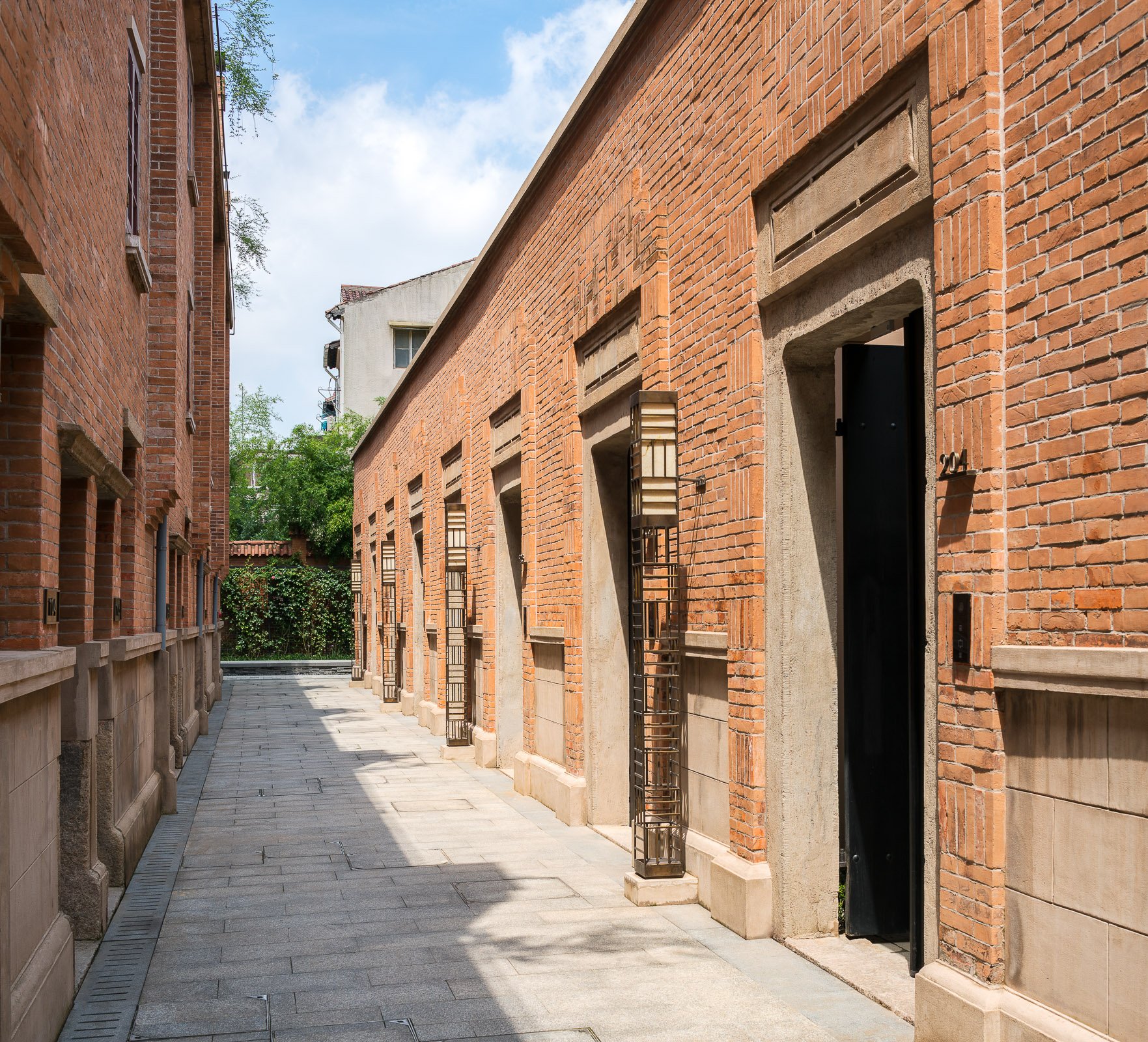
Originally built in the 1930s by French real estate company Foncière et Immobilière de Chine, the Jian Ye Li “shikumen” complex; located in the heart of the former French concession had evolved and been altered over the years but was essentially intact in its historical configuration and represented an incredible development opportunity.
Originally these “shikumen” buildings were designed for middle class families in Shanghai and as they lacked modern plumbing facilities they were often seen as products with little value to preserve and were either demolished or just the “shell” was maintained and they were converted it into commercial use. After extensive research and study, Kokaistudios developed an architectural renovation strategy that maintained the architectural features of the “shikumen” lane houses while tastefully altering the internal layout and transforming them into spaces suitable for modern luxurious living where each original lane house unit was transformed into one luxurious guest suite.
Practicality is not a term that applies to this project as the shikumen architectural typology; characterized by their narrow and tall nature meaning that the minimum 110 sq.m suites are split over 2 floors via a step staircase with no elevator; does not lend itself naturally to conversion to hospitality use. However when the ultra-luxury Capella hotel brand entered into the project several years later minimal upgrades to the architecture of the buildings were required to meet their exacting standards and they created 55 luxury suites each occupying one of the lane-houses.
Today the hotel occupies a unique position within Shanghai’s luxury hotel landscape and offer their guests a truly unique hospitality experience not available anywhere else in the world.
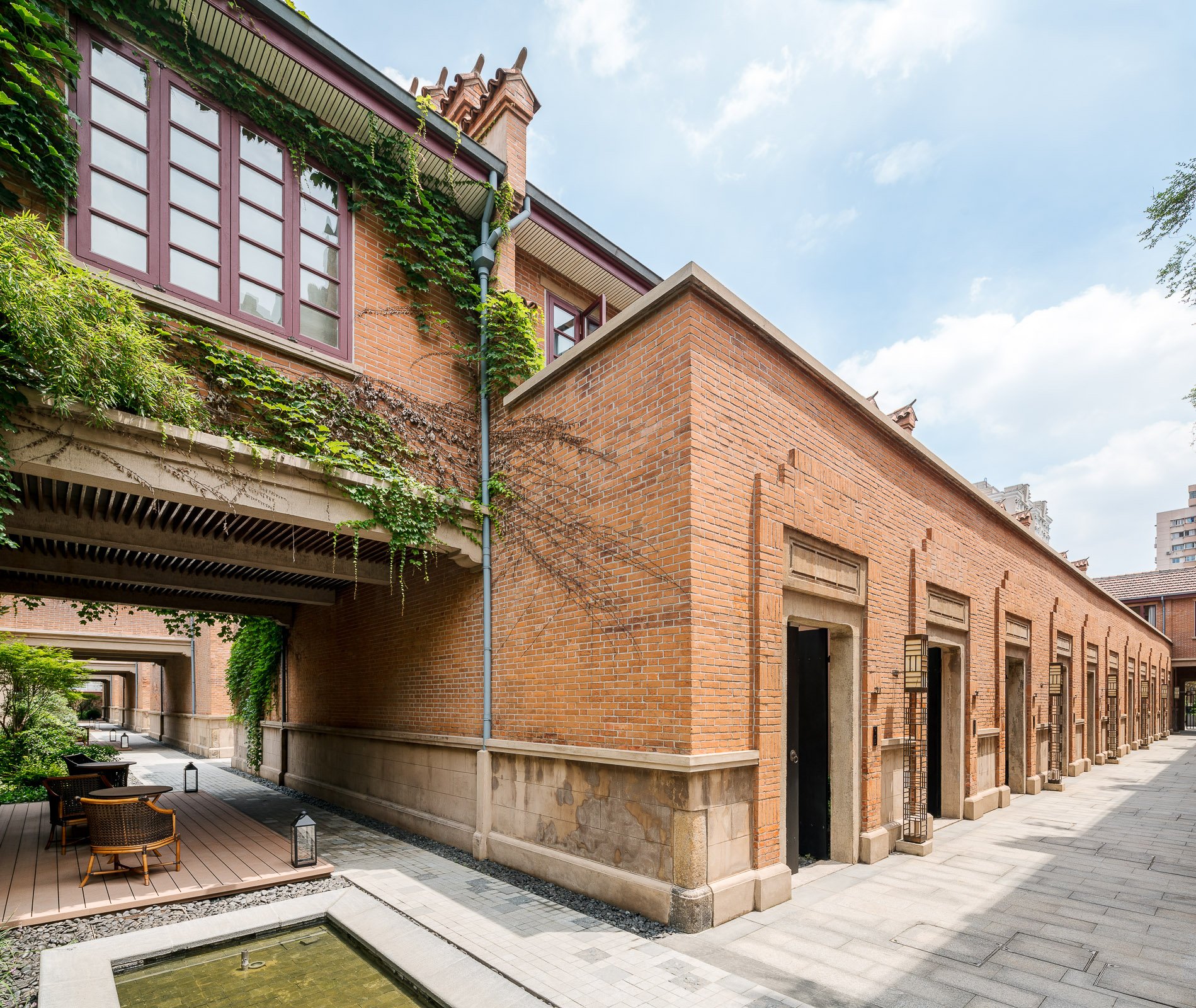
Originally built in the 1930s by French real estate company Foncière et Immobilière de Chine, the Jian Ye Li “shikumen” complex; located in the heart of the former French concession had evolved and been altered over the years but was essentially intact in its historical configuration and represented an incredible development opportunity.
Originally these “shikumen” buildings were designed for middle class families in Shanghai and as they lacked modern plumbing facilities they were often seen as products with little value to preserve and were either demolished or just the “shell” was maintained and they were converted it into commercial use. After extensive research and study, Kokaistudios developed an architectural renovation strategy that maintained the architectural features of the “shikumen” lane houses while tastefully altering the internal layout and transforming them into spaces suitable for modern luxurious living where each original lane house unit was transformed into one luxurious guest suite.
Practicality is not a term that applies to this project as the shikumen architectural typology; characterized by their narrow and tall nature meaning that the minimum 110 sq.m suites are split over 2 floors via a step staircase with no elevator; does not lend itself naturally to conversion to hospitality use. However when the ultra-luxury Capella hotel brand entered into the project several years later minimal upgrades to the architecture of the buildings were required to meet their exacting standards and they created 55 luxury suites each occupying one of the lane-houses.
Today the hotel occupies a unique position within Shanghai’s luxury hotel landscape and offer their guests a truly unique hospitality experience not available anywhere else in the world.
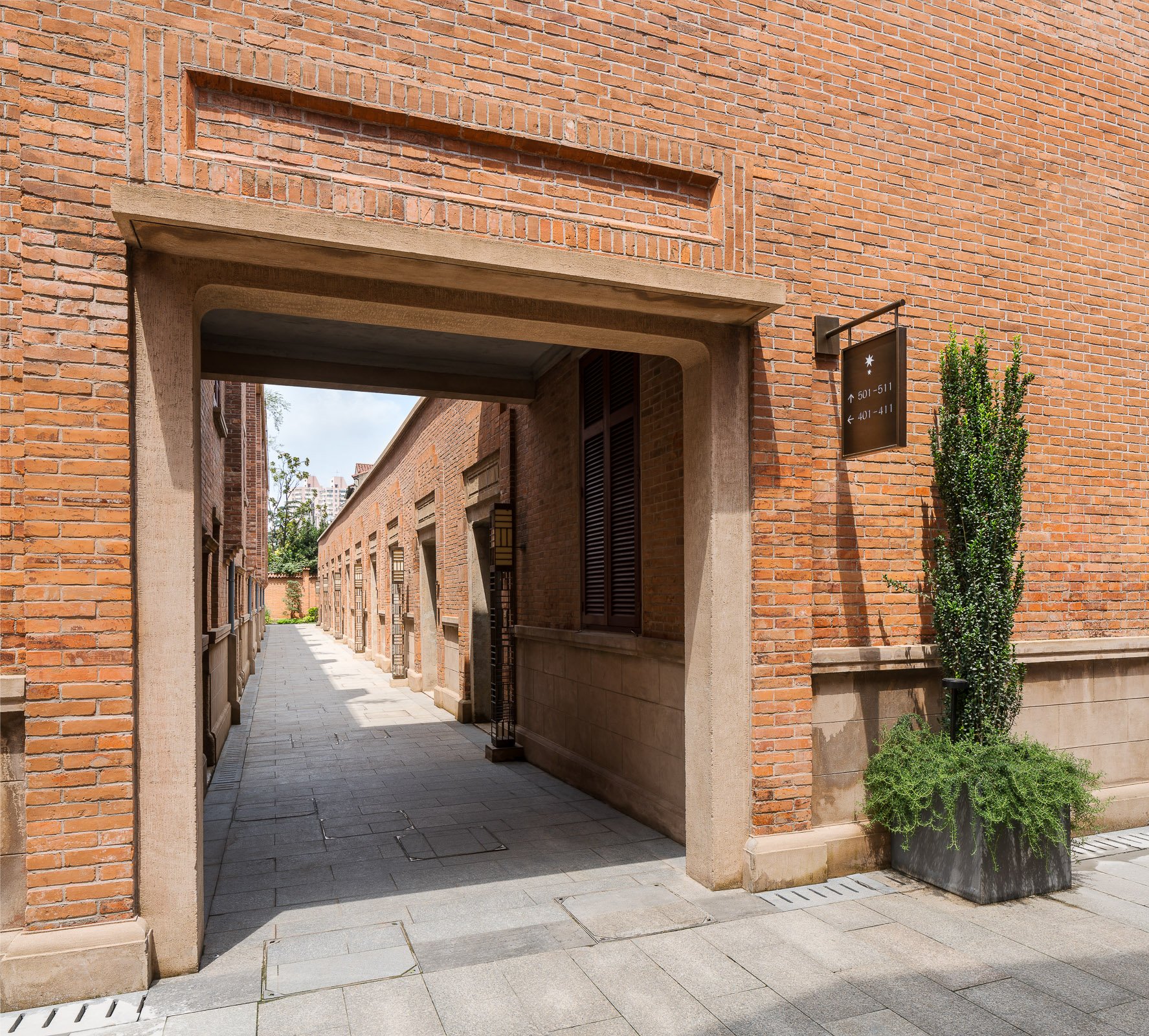
Originally built in the 1930s by French real estate company Foncière et Immobilière de Chine, the Jian Ye Li “shikumen” complex; located in the heart of the former French concession had evolved and been altered over the years but was essentially intact in its historical configuration and represented an incredible development opportunity.
Originally these “shikumen” buildings were designed for middle class families in Shanghai and as they lacked modern plumbing facilities they were often seen as products with little value to preserve and were either demolished or just the “shell” was maintained and they were converted it into commercial use. After extensive research and study, Kokaistudios developed an architectural renovation strategy that maintained the architectural features of the “shikumen” lane houses while tastefully altering the internal layout and transforming them into spaces suitable for modern luxurious living where each original lane house unit was transformed into one luxurious guest suite.
Practicality is not a term that applies to this project as the shikumen architectural typology; characterized by their narrow and tall nature meaning that the minimum 110 sq.m suites are split over 2 floors via a step staircase with no elevator; does not lend itself naturally to conversion to hospitality use. However when the ultra-luxury Capella hotel brand entered into the project several years later minimal upgrades to the architecture of the buildings were required to meet their exacting standards and they created 55 luxury suites each occupying one of the lane-houses.
Today the hotel occupies a unique position within Shanghai’s luxury hotel landscape and offer their guests a truly unique hospitality experience not available anywhere else in the world.
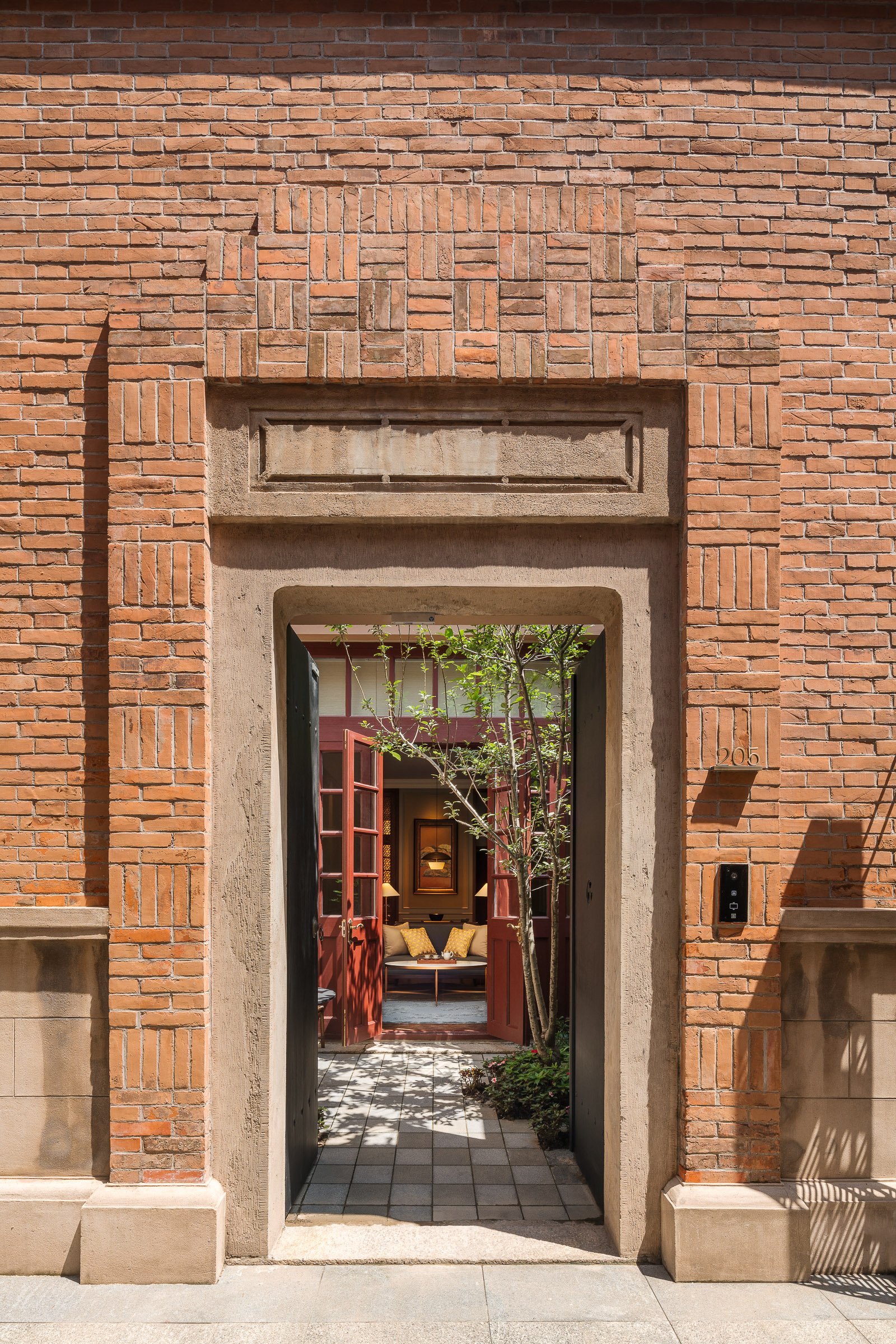
Originally built in the 1930s by French real estate company Foncière et Immobilière de Chine, the Jian Ye Li “shikumen” complex; located in the heart of the former French concession had evolved and been altered over the years but was essentially intact in its historical configuration and represented an incredible development opportunity.
Originally these “shikumen” buildings were designed for middle class families in Shanghai and as they lacked modern plumbing facilities they were often seen as products with little value to preserve and were either demolished or just the “shell” was maintained and they were converted it into commercial use. After extensive research and study, Kokaistudios developed an architectural renovation strategy that maintained the architectural features of the “shikumen” lane houses while tastefully altering the internal layout and transforming them into spaces suitable for modern luxurious living where each original lane house unit was transformed into one luxurious guest suite.
Practicality is not a term that applies to this project as the shikumen architectural typology; characterized by their narrow and tall nature meaning that the minimum 110 sq.m suites are split over 2 floors via a step staircase with no elevator; does not lend itself naturally to conversion to hospitality use. However when the ultra-luxury Capella hotel brand entered into the project several years later minimal upgrades to the architecture of the buildings were required to meet their exacting standards and they created 55 luxury suites each occupying one of the lane-houses.
Today the hotel occupies a unique position within Shanghai’s luxury hotel landscape and offer their guests a truly unique hospitality experience not available anywhere else in the world.

Originally built in the 1930s by French real estate company Foncière et Immobilière de Chine, the Jian Ye Li “shikumen” complex; located in the heart of the former French concession had evolved and been altered over the years but was essentially intact in its historical configuration and represented an incredible development opportunity.
Originally these “shikumen” buildings were designed for middle class families in Shanghai and as they lacked modern plumbing facilities they were often seen as products with little value to preserve and were either demolished or just the “shell” was maintained and they were converted it into commercial use. After extensive research and study, Kokaistudios developed an architectural renovation strategy that maintained the architectural features of the “shikumen” lane houses while tastefully altering the internal layout and transforming them into spaces suitable for modern luxurious living where each original lane house unit was transformed into one luxurious guest suite.
Practicality is not a term that applies to this project as the shikumen architectural typology; characterized by their narrow and tall nature meaning that the minimum 110 sq.m suites are split over 2 floors via a step staircase with no elevator; does not lend itself naturally to conversion to hospitality use. However when the ultra-luxury Capella hotel brand entered into the project several years later minimal upgrades to the architecture of the buildings were required to meet their exacting standards and they created 55 luxury suites each occupying one of the lane-houses.
Today the hotel occupies a unique position within Shanghai’s luxury hotel landscape and offer their guests a truly unique hospitality experience not available anywhere else in the world.
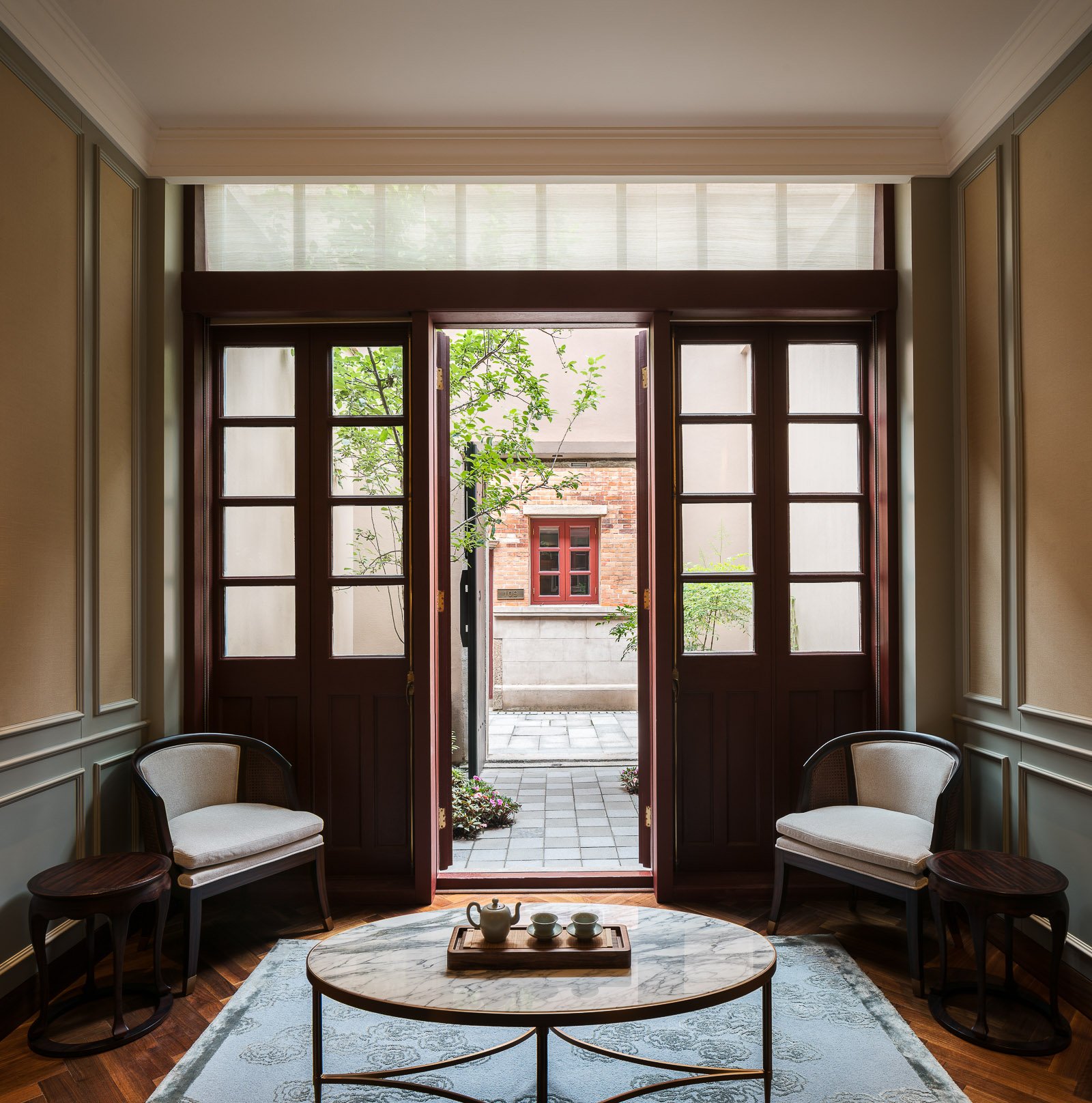
Originally built in the 1930s by French real estate company Foncière et Immobilière de Chine, the Jian Ye Li “shikumen” complex; located in the heart of the former French concession had evolved and been altered over the years but was essentially intact in its historical configuration and represented an incredible development opportunity.
Originally these “shikumen” buildings were designed for middle class families in Shanghai and as they lacked modern plumbing facilities they were often seen as products with little value to preserve and were either demolished or just the “shell” was maintained and they were converted it into commercial use. After extensive research and study, Kokaistudios developed an architectural renovation strategy that maintained the architectural features of the “shikumen” lane houses while tastefully altering the internal layout and transforming them into spaces suitable for modern luxurious living where each original lane house unit was transformed into one luxurious guest suite.
Practicality is not a term that applies to this project as the shikumen architectural typology; characterized by their narrow and tall nature meaning that the minimum 110 sq.m suites are split over 2 floors via a step staircase with no elevator; does not lend itself naturally to conversion to hospitality use. However when the ultra-luxury Capella hotel brand entered into the project several years later minimal upgrades to the architecture of the buildings were required to meet their exacting standards and they created 55 luxury suites each occupying one of the lane-houses.
Today the hotel occupies a unique position within Shanghai’s luxury hotel landscape and offer their guests a truly unique hospitality experience not available anywhere else in the world.
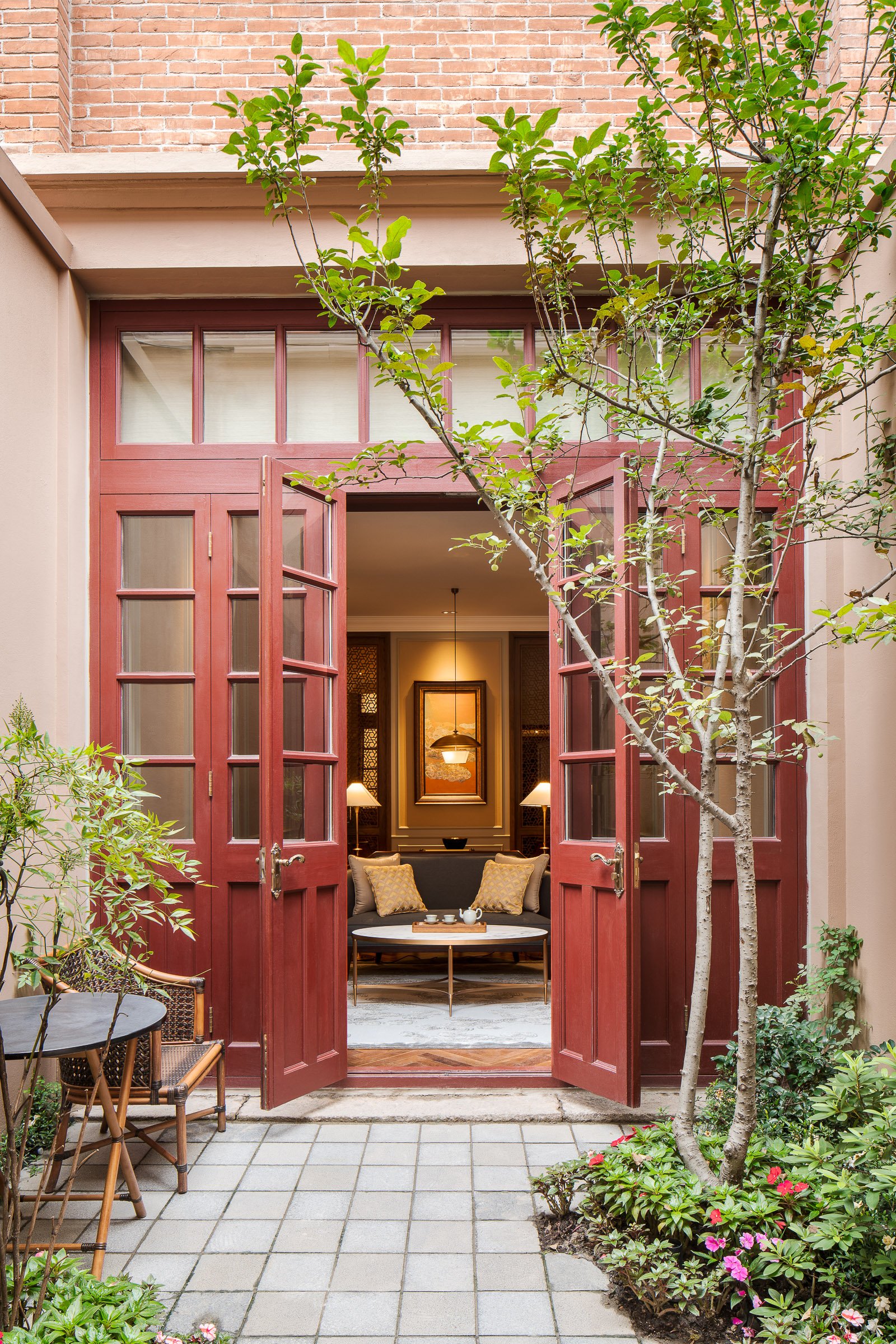
Originally built in the 1930s by French real estate company Foncière et Immobilière de Chine, the Jian Ye Li “shikumen” complex; located in the heart of the former French concession had evolved and been altered over the years but was essentially intact in its historical configuration and represented an incredible development opportunity.
Originally these “shikumen” buildings were designed for middle class families in Shanghai and as they lacked modern plumbing facilities they were often seen as products with little value to preserve and were either demolished or just the “shell” was maintained and they were converted it into commercial use. After extensive research and study, Kokaistudios developed an architectural renovation strategy that maintained the architectural features of the “shikumen” lane houses while tastefully altering the internal layout and transforming them into spaces suitable for modern luxurious living where each original lane house unit was transformed into one luxurious guest suite.
Practicality is not a term that applies to this project as the shikumen architectural typology; characterized by their narrow and tall nature meaning that the minimum 110 sq.m suites are split over 2 floors via a step staircase with no elevator; does not lend itself naturally to conversion to hospitality use. However when the ultra-luxury Capella hotel brand entered into the project several years later minimal upgrades to the architecture of the buildings were required to meet their exacting standards and they created 55 luxury suites each occupying one of the lane-houses.
Today the hotel occupies a unique position within Shanghai’s luxury hotel landscape and offer their guests a truly unique hospitality experience not available anywhere else in the world.
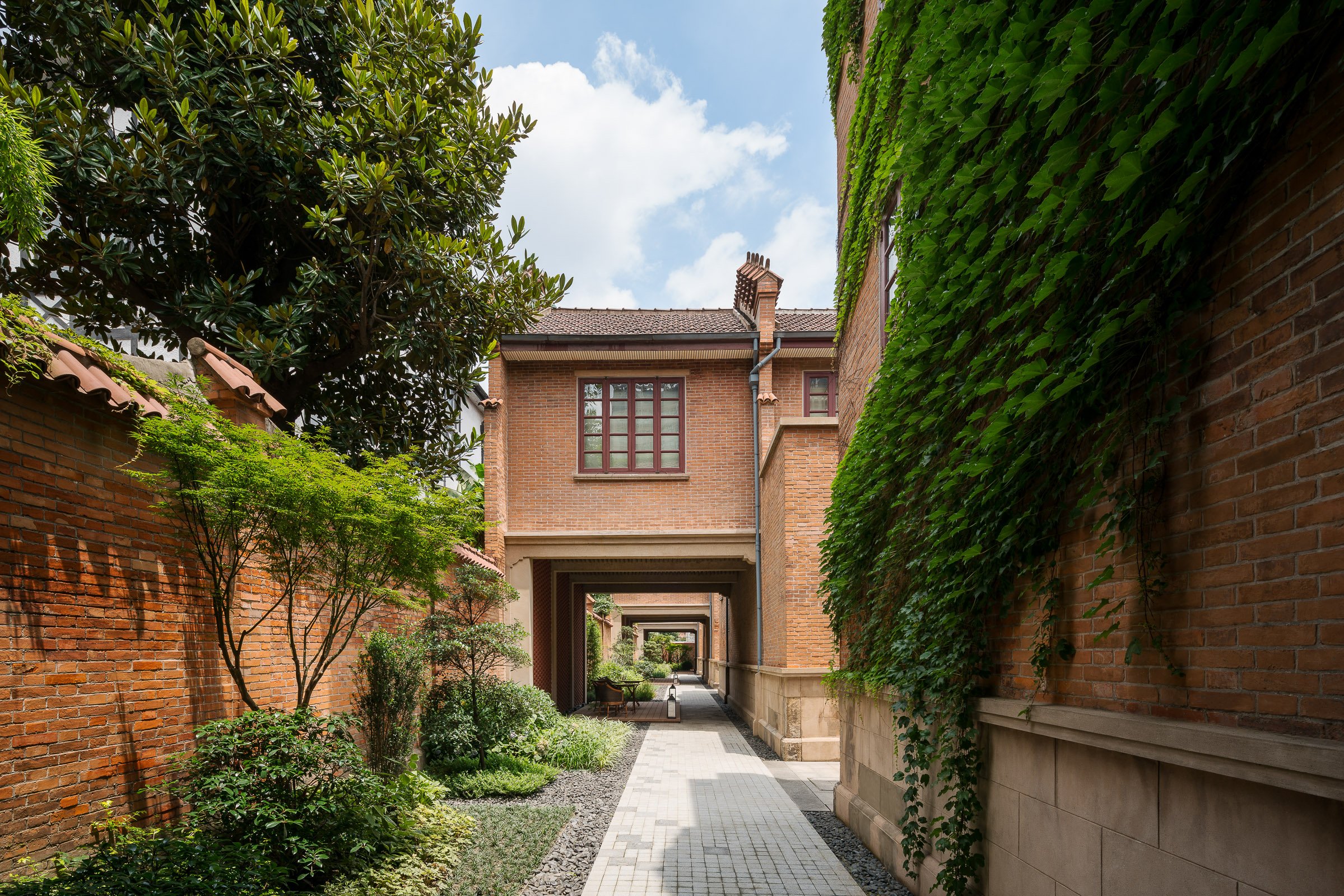
Originally built in the 1930s by French real estate company Foncière et Immobilière de Chine, the Jian Ye Li “shikumen” complex; located in the heart of the former French concession had evolved and been altered over the years but was essentially intact in its historical configuration and represented an incredible development opportunity.
Originally these “shikumen” buildings were designed for middle class families in Shanghai and as they lacked modern plumbing facilities they were often seen as products with little value to preserve and were either demolished or just the “shell” was maintained and they were converted it into commercial use. After extensive research and study, Kokaistudios developed an architectural renovation strategy that maintained the architectural features of the “shikumen” lane houses while tastefully altering the internal layout and transforming them into spaces suitable for modern luxurious living where each original lane house unit was transformed into one luxurious guest suite.
Practicality is not a term that applies to this project as the shikumen architectural typology; characterized by their narrow and tall nature meaning that the minimum 110 sq.m suites are split over 2 floors via a step staircase with no elevator; does not lend itself naturally to conversion to hospitality use. However when the ultra-luxury Capella hotel brand entered into the project several years later minimal upgrades to the architecture of the buildings were required to meet their exacting standards and they created 55 luxury suites each occupying one of the lane-houses.
Today the hotel occupies a unique position within Shanghai’s luxury hotel landscape and offer their guests a truly unique hospitality experience not available anywhere else in the world.
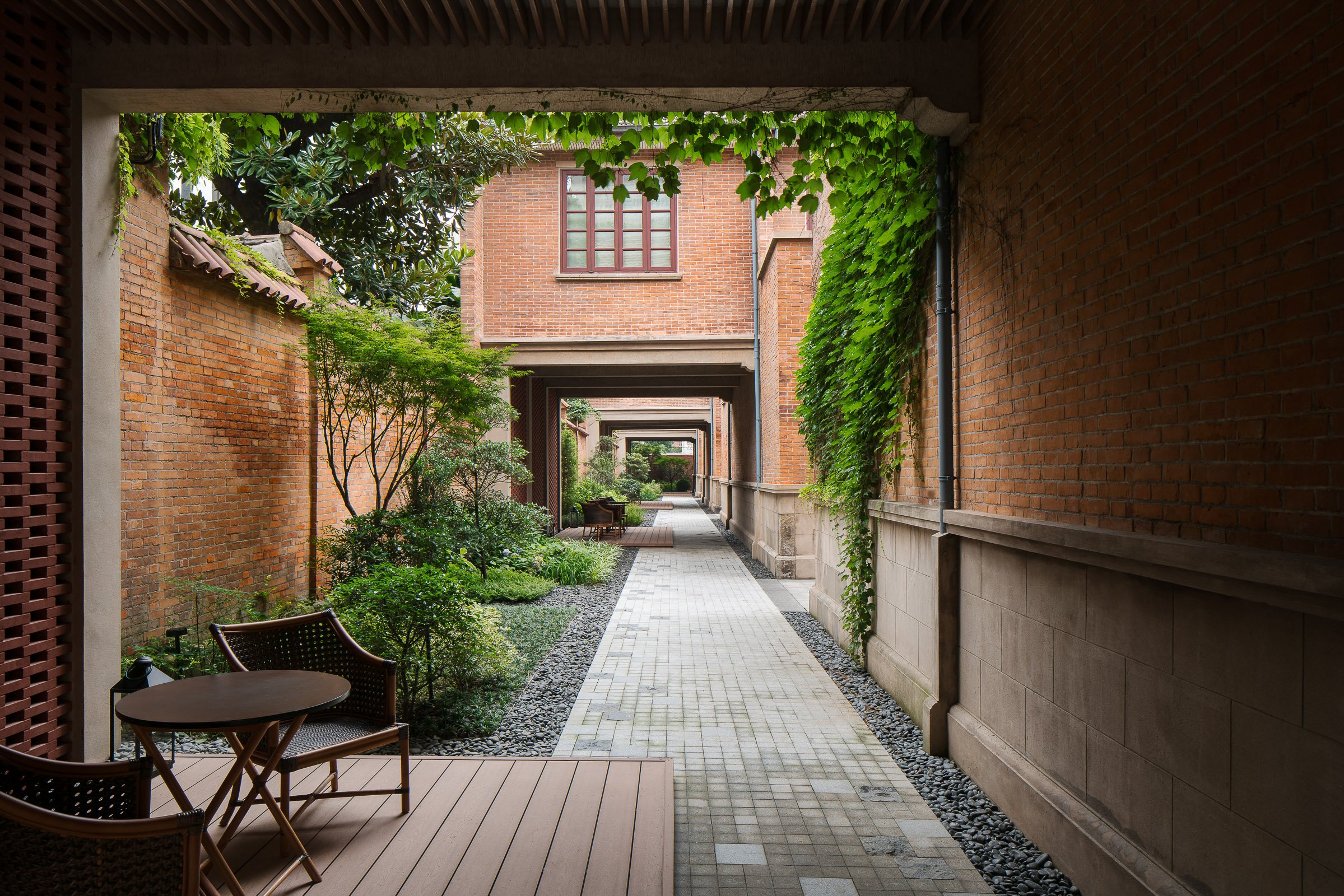
Originally built in the 1930s by French real estate company Foncière et Immobilière de Chine, the Jian Ye Li “shikumen” complex; located in the heart of the former French concession had evolved and been altered over the years but was essentially intact in its historical configuration and represented an incredible development opportunity.
Originally these “shikumen” buildings were designed for middle class families in Shanghai and as they lacked modern plumbing facilities they were often seen as products with little value to preserve and were either demolished or just the “shell” was maintained and they were converted it into commercial use. After extensive research and study, Kokaistudios developed an architectural renovation strategy that maintained the architectural features of the “shikumen” lane houses while tastefully altering the internal layout and transforming them into spaces suitable for modern luxurious living where each original lane house unit was transformed into one luxurious guest suite.
Practicality is not a term that applies to this project as the shikumen architectural typology; characterized by their narrow and tall nature meaning that the minimum 110 sq.m suites are split over 2 floors via a step staircase with no elevator; does not lend itself naturally to conversion to hospitality use. However when the ultra-luxury Capella hotel brand entered into the project several years later minimal upgrades to the architecture of the buildings were required to meet their exacting standards and they created 55 luxury suites each occupying one of the lane-houses.
Today the hotel occupies a unique position within Shanghai’s luxury hotel landscape and offer their guests a truly unique hospitality experience not available anywhere else in the world.
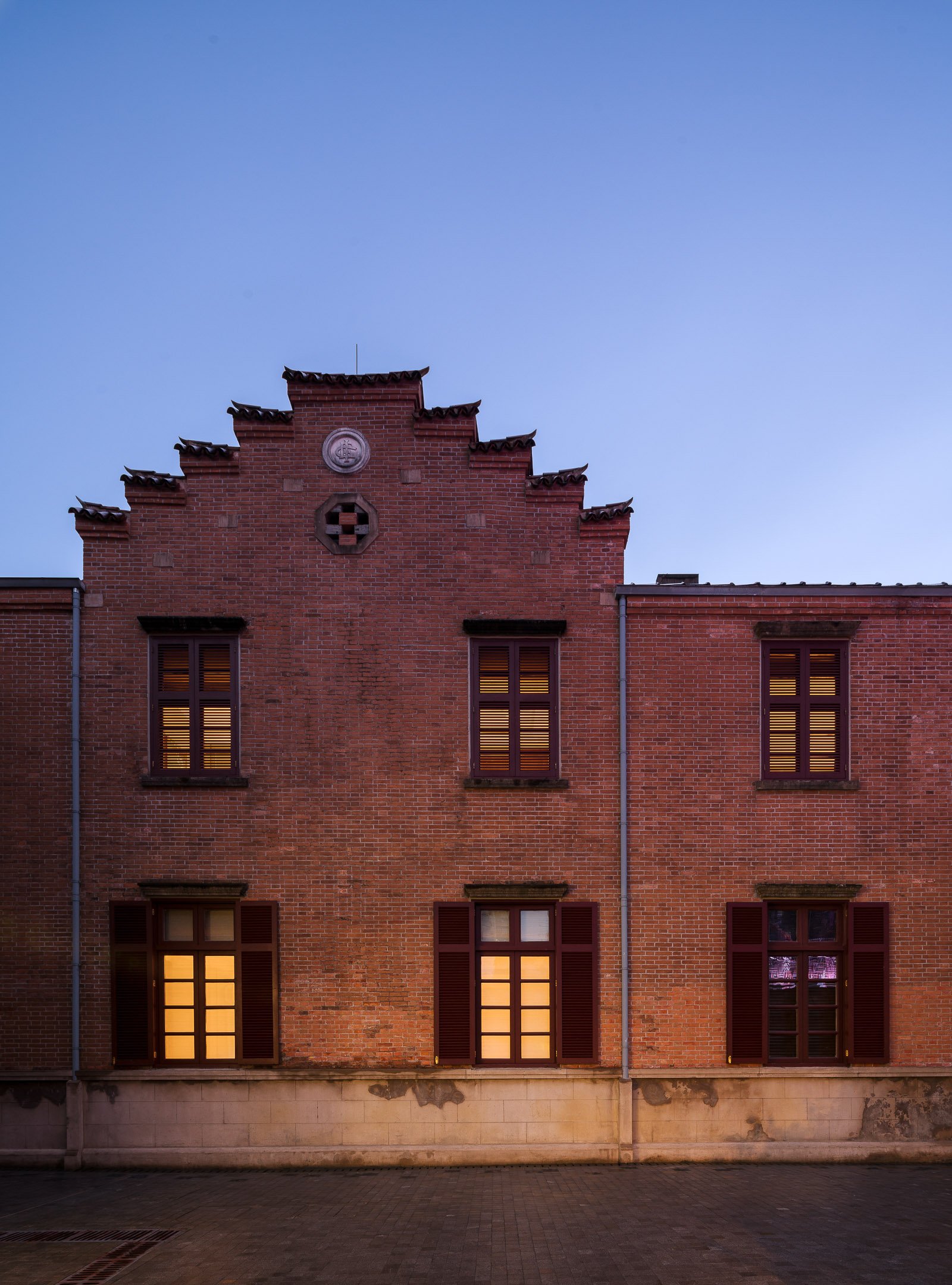
Originally built in the 1930s by French real estate company Foncière et Immobilière de Chine, the Jian Ye Li “shikumen” complex; located in the heart of the former French concession had evolved and been altered over the years but was essentially intact in its historical configuration and represented an incredible development opportunity.
Originally these “shikumen” buildings were designed for middle class families in Shanghai and as they lacked modern plumbing facilities they were often seen as products with little value to preserve and were either demolished or just the “shell” was maintained and they were converted it into commercial use. After extensive research and study, Kokaistudios developed an architectural renovation strategy that maintained the architectural features of the “shikumen” lane houses while tastefully altering the internal layout and transforming them into spaces suitable for modern luxurious living where each original lane house unit was transformed into one luxurious guest suite.
Practicality is not a term that applies to this project as the shikumen architectural typology; characterized by their narrow and tall nature meaning that the minimum 110 sq.m suites are split over 2 floors via a step staircase with no elevator; does not lend itself naturally to conversion to hospitality use. However when the ultra-luxury Capella hotel brand entered into the project several years later minimal upgrades to the architecture of the buildings were required to meet their exacting standards and they created 55 luxury suites each occupying one of the lane-houses.
Today the hotel occupies a unique position within Shanghai’s luxury hotel landscape and offer their guests a truly unique hospitality experience not available anywhere else in the world.
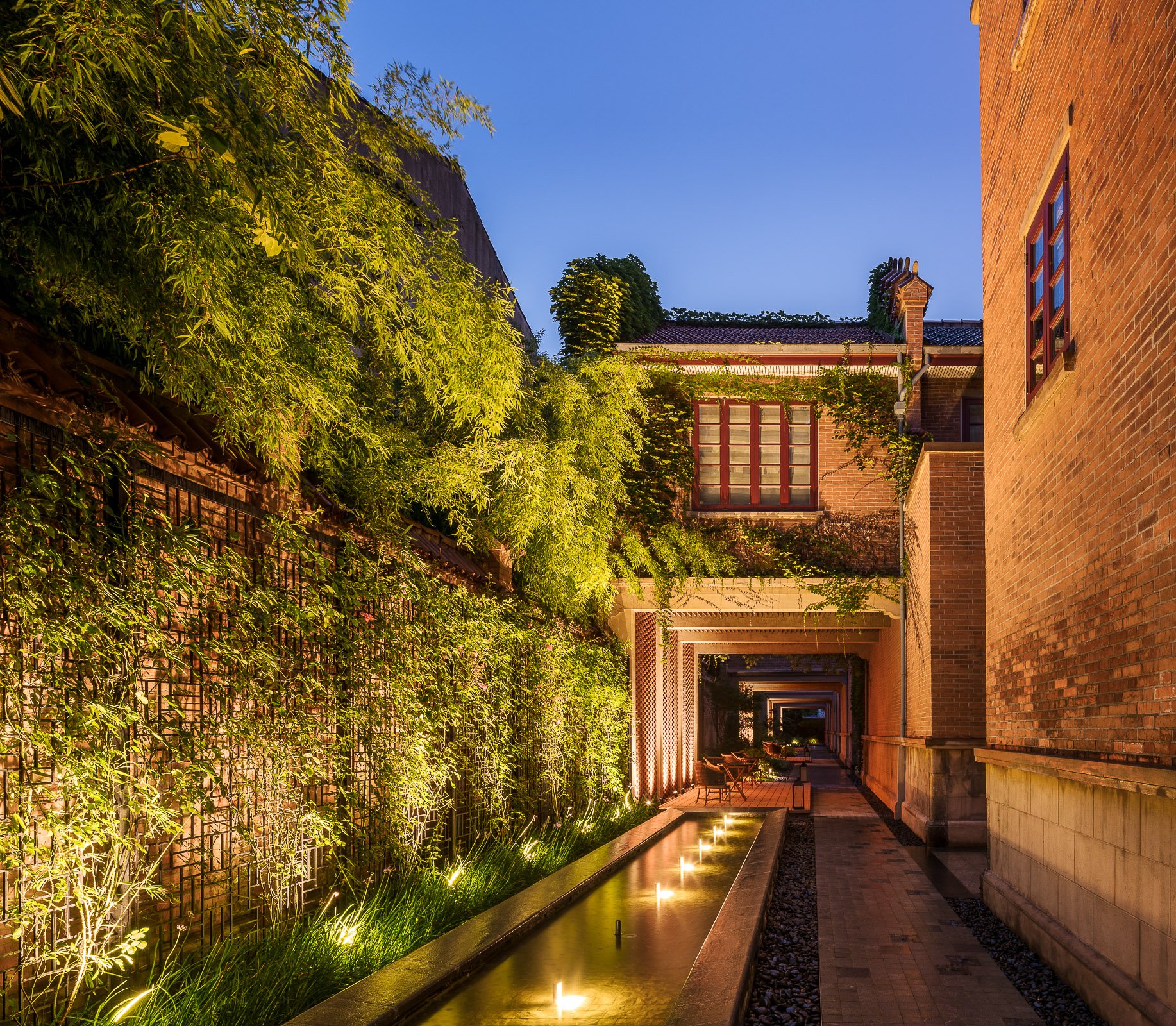
Originally built in the 1930s by French real estate company Foncière et Immobilière de Chine, the Jian Ye Li “shikumen” complex; located in the heart of the former French concession had evolved and been altered over the years but was essentially intact in its historical configuration and represented an incredible development opportunity.
Originally these “shikumen” buildings were designed for middle class families in Shanghai and as they lacked modern plumbing facilities they were often seen as products with little value to preserve and were either demolished or just the “shell” was maintained and they were converted it into commercial use. After extensive research and study, Kokaistudios developed an architectural renovation strategy that maintained the architectural features of the “shikumen” lane houses while tastefully altering the internal layout and transforming them into spaces suitable for modern luxurious living where each original lane house unit was transformed into one luxurious guest suite.
Practicality is not a term that applies to this project as the shikumen architectural typology; characterized by their narrow and tall nature meaning that the minimum 110 sq.m suites are split over 2 floors via a step staircase with no elevator; does not lend itself naturally to conversion to hospitality use. However when the ultra-luxury Capella hotel brand entered into the project several years later minimal upgrades to the architecture of the buildings were required to meet their exacting standards and they created 55 luxury suites each occupying one of the lane-houses.
Today the hotel occupies a unique position within Shanghai’s luxury hotel landscape and offer their guests a truly unique hospitality experience not available anywhere else in the world.
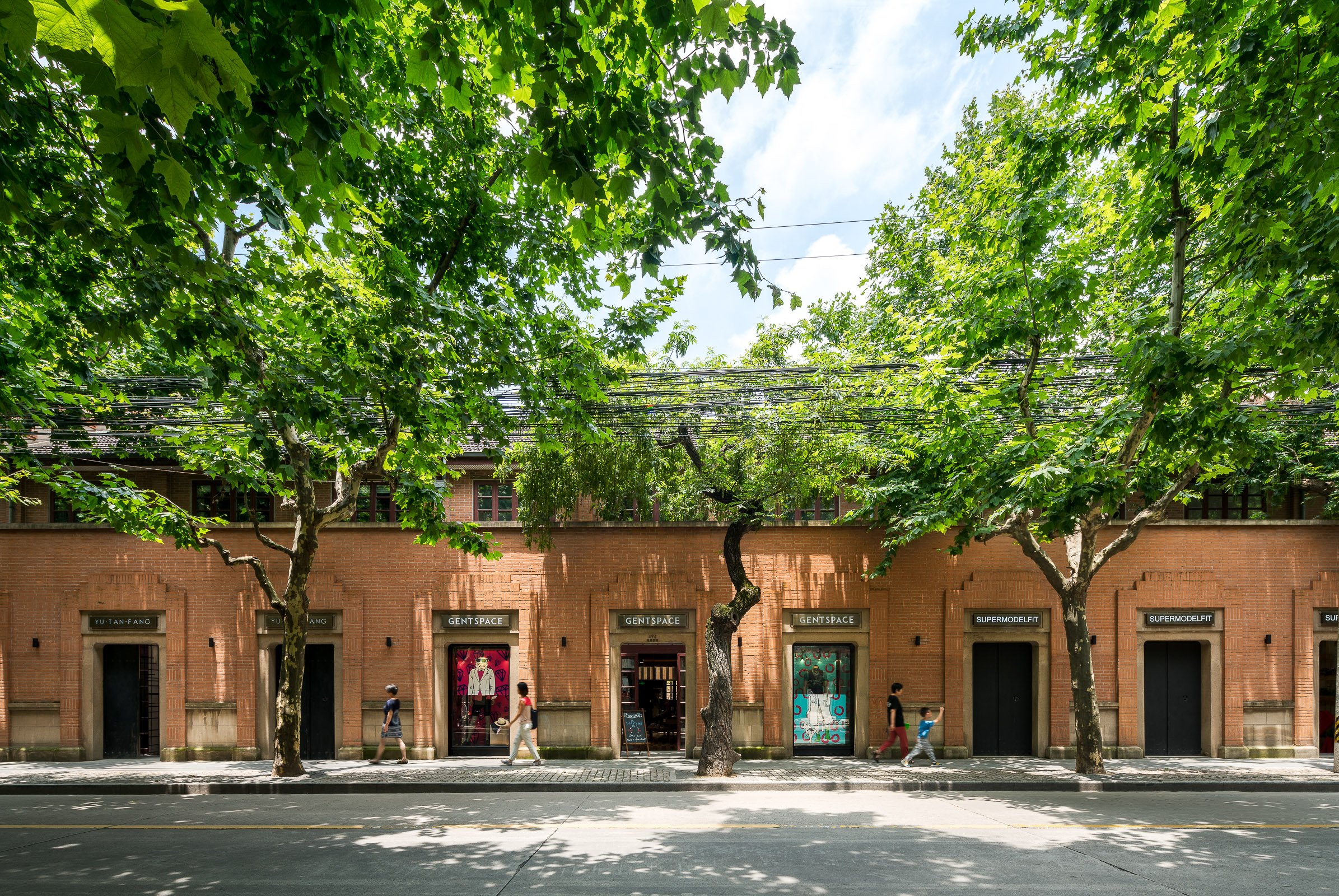
Originally built in the 1930s by French real estate company Foncière et Immobilière de Chine, the Jian Ye Li “shikumen” complex; located in the heart of the former French concession had evolved and been altered over the years but was essentially intact in its historical configuration and represented an incredible development opportunity.
Originally these “shikumen” buildings were designed for middle class families in Shanghai and as they lacked modern plumbing facilities they were often seen as products with little value to preserve and were either demolished or just the “shell” was maintained and they were converted it into commercial use. After extensive research and study, Kokaistudios developed an architectural renovation strategy that maintained the architectural features of the “shikumen” lane houses while tastefully altering the internal layout and transforming them into spaces suitable for modern luxurious living where each original lane house unit was transformed into one luxurious guest suite.
Practicality is not a term that applies to this project as the shikumen architectural typology; characterized by their narrow and tall nature meaning that the minimum 110 sq.m suites are split over 2 floors via a step staircase with no elevator; does not lend itself naturally to conversion to hospitality use. However when the ultra-luxury Capella hotel brand entered into the project several years later minimal upgrades to the architecture of the buildings were required to meet their exacting standards and they created 55 luxury suites each occupying one of the lane-houses.
Today the hotel occupies a unique position within Shanghai’s luxury hotel landscape and offer their guests a truly unique hospitality experience not available anywhere else in the world.
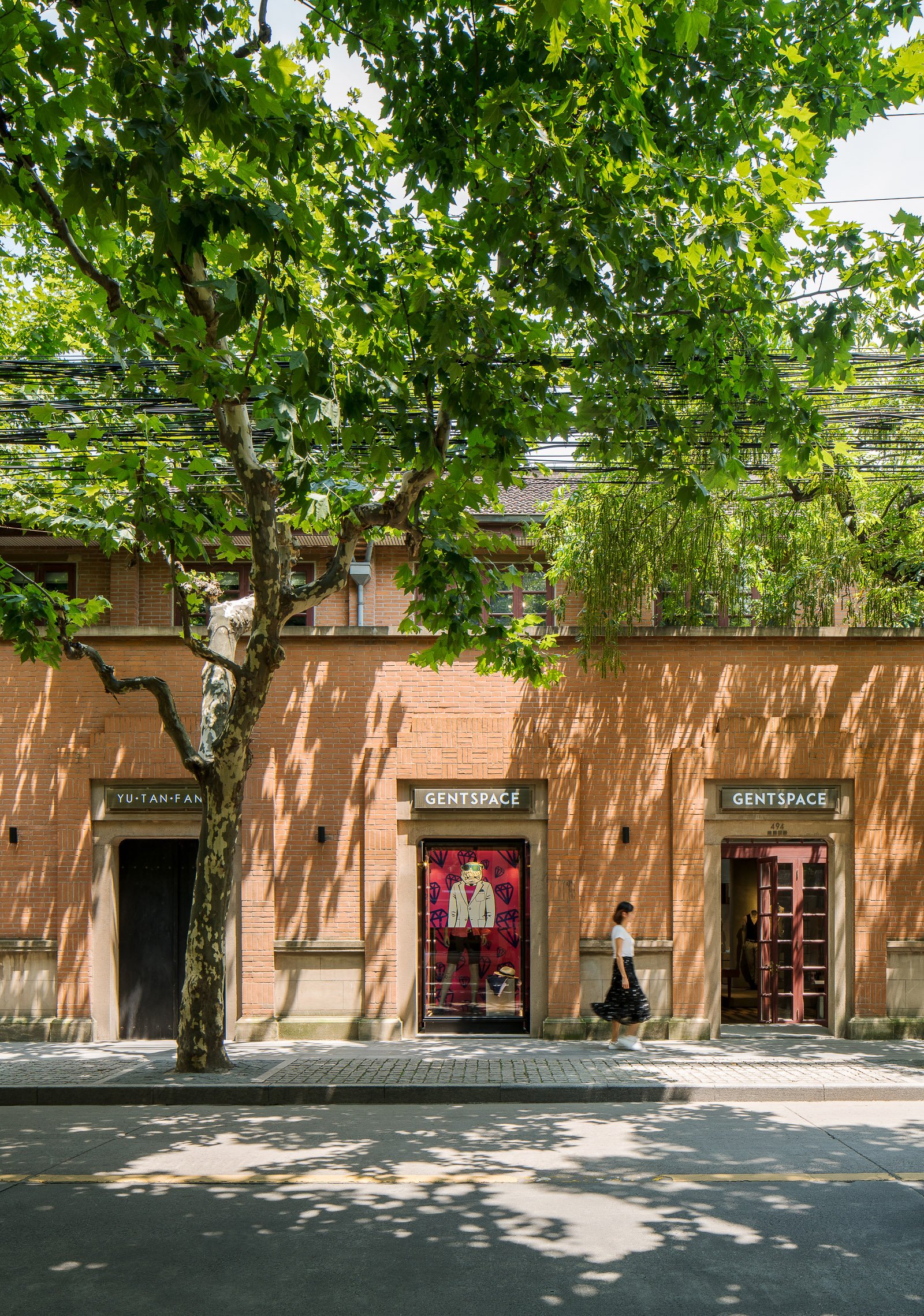
Originally built in the 1930s by French real estate company Foncière et Immobilière de Chine, the Jian Ye Li “shikumen” complex; located in the heart of the former French concession had evolved and been altered over the years but was essentially intact in its historical configuration and represented an incredible development opportunity.
Originally these “shikumen” buildings were designed for middle class families in Shanghai and as they lacked modern plumbing facilities they were often seen as products with little value to preserve and were either demolished or just the “shell” was maintained and they were converted it into commercial use. After extensive research and study, Kokaistudios developed an architectural renovation strategy that maintained the architectural features of the “shikumen” lane houses while tastefully altering the internal layout and transforming them into spaces suitable for modern luxurious living where each original lane house unit was transformed into one luxurious guest suite.
Practicality is not a term that applies to this project as the shikumen architectural typology; characterized by their narrow and tall nature meaning that the minimum 110 sq.m suites are split over 2 floors via a step staircase with no elevator; does not lend itself naturally to conversion to hospitality use. However when the ultra-luxury Capella hotel brand entered into the project several years later minimal upgrades to the architecture of the buildings were required to meet their exacting standards and they created 55 luxury suites each occupying one of the lane-houses.
Today the hotel occupies a unique position within Shanghai’s luxury hotel landscape and offer their guests a truly unique hospitality experience not available anywhere else in the world.















Originally built in the 1930s by French real estate company Foncière et Immobilière de Chine, the Jian Ye Li “shikumen” complex; located in the heart of the former French concession had evolved and been altered over the years but was essentially intact in its historical configuration and represented an incredible development opportunity.
Originally these “shikumen” buildings were designed for middle class families in Shanghai and as they lacked modern plumbing facilities they were often seen as products with little value to preserve and were either demolished or just the “shell” was maintained and they were converted it into commercial use. After extensive research and study, Kokaistudios developed an architectural renovation strategy that maintained the architectural features of the “shikumen” lane houses while tastefully altering the internal layout and transforming them into spaces suitable for modern luxurious living where each original lane house unit was transformed into one luxurious guest suite.
Practicality is not a term that applies to this project as the shikumen architectural typology; characterized by their narrow and tall nature meaning that the minimum 110 sq.m suites are split over 2 floors via a step staircase with no elevator; does not lend itself naturally to conversion to hospitality use. However when the ultra-luxury Capella hotel brand entered into the project several years later minimal upgrades to the architecture of the buildings were required to meet their exacting standards and they created 55 luxury suites each occupying one of the lane-houses.
Today the hotel occupies a unique position within Shanghai’s luxury hotel landscape and offer their guests a truly unique hospitality experience not available anywhere else in the world.
Originally built in the 1930s by French real estate company Foncière et Immobilière de Chine, the Jian Ye Li “shikumen” complex; located in the heart of the former French concession had evolved and been altered over the years but was essentially intact in its historical configuration and represented an incredible development opportunity.
Originally these “shikumen” buildings were designed for middle class families in Shanghai and as they lacked modern plumbing facilities they were often seen as products with little value to preserve and were either demolished or just the “shell” was maintained and they were converted it into commercial use. After extensive research and study, Kokaistudios developed an architectural renovation strategy that maintained the architectural features of the “shikumen” lane houses while tastefully altering the internal layout and transforming them into spaces suitable for modern luxurious living where each original lane house unit was transformed into one luxurious guest suite.
Practicality is not a term that applies to this project as the shikumen architectural typology; characterized by their narrow and tall nature meaning that the minimum 110 sq.m suites are split over 2 floors via a step staircase with no elevator; does not lend itself naturally to conversion to hospitality use. However when the ultra-luxury Capella hotel brand entered into the project several years later minimal upgrades to the architecture of the buildings were required to meet their exacting standards and they created 55 luxury suites each occupying one of the lane-houses.
Today the hotel occupies a unique position within Shanghai’s luxury hotel landscape and offer their guests a truly unique hospitality experience not available anywhere else in the world.
Originally built in the 1930s by French real estate company Foncière et Immobilière de Chine, the Jian Ye Li “shikumen” complex; located in the heart of the former French concession had evolved and been altered over the years but was essentially intact in its historical configuration and represented an incredible development opportunity.
Originally these “shikumen” buildings were designed for middle class families in Shanghai and as they lacked modern plumbing facilities they were often seen as products with little value to preserve and were either demolished or just the “shell” was maintained and they were converted it into commercial use. After extensive research and study, Kokaistudios developed an architectural renovation strategy that maintained the architectural features of the “shikumen” lane houses while tastefully altering the internal layout and transforming them into spaces suitable for modern luxurious living where each original lane house unit was transformed into one luxurious guest suite.
Practicality is not a term that applies to this project as the shikumen architectural typology; characterized by their narrow and tall nature meaning that the minimum 110 sq.m suites are split over 2 floors via a step staircase with no elevator; does not lend itself naturally to conversion to hospitality use. However when the ultra-luxury Capella hotel brand entered into the project several years later minimal upgrades to the architecture of the buildings were required to meet their exacting standards and they created 55 luxury suites each occupying one of the lane-houses.
Today the hotel occupies a unique position within Shanghai’s luxury hotel landscape and offer their guests a truly unique hospitality experience not available anywhere else in the world.
Originally built in the 1930s by French real estate company Foncière et Immobilière de Chine, the Jian Ye Li “shikumen” complex; located in the heart of the former French concession had evolved and been altered over the years but was essentially intact in its historical configuration and represented an incredible development opportunity.
Originally these “shikumen” buildings were designed for middle class families in Shanghai and as they lacked modern plumbing facilities they were often seen as products with little value to preserve and were either demolished or just the “shell” was maintained and they were converted it into commercial use. After extensive research and study, Kokaistudios developed an architectural renovation strategy that maintained the architectural features of the “shikumen” lane houses while tastefully altering the internal layout and transforming them into spaces suitable for modern luxurious living where each original lane house unit was transformed into one luxurious guest suite.
Practicality is not a term that applies to this project as the shikumen architectural typology; characterized by their narrow and tall nature meaning that the minimum 110 sq.m suites are split over 2 floors via a step staircase with no elevator; does not lend itself naturally to conversion to hospitality use. However when the ultra-luxury Capella hotel brand entered into the project several years later minimal upgrades to the architecture of the buildings were required to meet their exacting standards and they created 55 luxury suites each occupying one of the lane-houses.
Today the hotel occupies a unique position within Shanghai’s luxury hotel landscape and offer their guests a truly unique hospitality experience not available anywhere else in the world.
Originally built in the 1930s by French real estate company Foncière et Immobilière de Chine, the Jian Ye Li “shikumen” complex; located in the heart of the former French concession had evolved and been altered over the years but was essentially intact in its historical configuration and represented an incredible development opportunity.
Originally these “shikumen” buildings were designed for middle class families in Shanghai and as they lacked modern plumbing facilities they were often seen as products with little value to preserve and were either demolished or just the “shell” was maintained and they were converted it into commercial use. After extensive research and study, Kokaistudios developed an architectural renovation strategy that maintained the architectural features of the “shikumen” lane houses while tastefully altering the internal layout and transforming them into spaces suitable for modern luxurious living where each original lane house unit was transformed into one luxurious guest suite.
Practicality is not a term that applies to this project as the shikumen architectural typology; characterized by their narrow and tall nature meaning that the minimum 110 sq.m suites are split over 2 floors via a step staircase with no elevator; does not lend itself naturally to conversion to hospitality use. However when the ultra-luxury Capella hotel brand entered into the project several years later minimal upgrades to the architecture of the buildings were required to meet their exacting standards and they created 55 luxury suites each occupying one of the lane-houses.
Today the hotel occupies a unique position within Shanghai’s luxury hotel landscape and offer their guests a truly unique hospitality experience not available anywhere else in the world.
Originally built in the 1930s by French real estate company Foncière et Immobilière de Chine, the Jian Ye Li “shikumen” complex; located in the heart of the former French concession had evolved and been altered over the years but was essentially intact in its historical configuration and represented an incredible development opportunity.
Originally these “shikumen” buildings were designed for middle class families in Shanghai and as they lacked modern plumbing facilities they were often seen as products with little value to preserve and were either demolished or just the “shell” was maintained and they were converted it into commercial use. After extensive research and study, Kokaistudios developed an architectural renovation strategy that maintained the architectural features of the “shikumen” lane houses while tastefully altering the internal layout and transforming them into spaces suitable for modern luxurious living where each original lane house unit was transformed into one luxurious guest suite.
Practicality is not a term that applies to this project as the shikumen architectural typology; characterized by their narrow and tall nature meaning that the minimum 110 sq.m suites are split over 2 floors via a step staircase with no elevator; does not lend itself naturally to conversion to hospitality use. However when the ultra-luxury Capella hotel brand entered into the project several years later minimal upgrades to the architecture of the buildings were required to meet their exacting standards and they created 55 luxury suites each occupying one of the lane-houses.
Today the hotel occupies a unique position within Shanghai’s luxury hotel landscape and offer their guests a truly unique hospitality experience not available anywhere else in the world.
Originally built in the 1930s by French real estate company Foncière et Immobilière de Chine, the Jian Ye Li “shikumen” complex; located in the heart of the former French concession had evolved and been altered over the years but was essentially intact in its historical configuration and represented an incredible development opportunity.
Originally these “shikumen” buildings were designed for middle class families in Shanghai and as they lacked modern plumbing facilities they were often seen as products with little value to preserve and were either demolished or just the “shell” was maintained and they were converted it into commercial use. After extensive research and study, Kokaistudios developed an architectural renovation strategy that maintained the architectural features of the “shikumen” lane houses while tastefully altering the internal layout and transforming them into spaces suitable for modern luxurious living where each original lane house unit was transformed into one luxurious guest suite.
Practicality is not a term that applies to this project as the shikumen architectural typology; characterized by their narrow and tall nature meaning that the minimum 110 sq.m suites are split over 2 floors via a step staircase with no elevator; does not lend itself naturally to conversion to hospitality use. However when the ultra-luxury Capella hotel brand entered into the project several years later minimal upgrades to the architecture of the buildings were required to meet their exacting standards and they created 55 luxury suites each occupying one of the lane-houses.
Today the hotel occupies a unique position within Shanghai’s luxury hotel landscape and offer their guests a truly unique hospitality experience not available anywhere else in the world.
Originally built in the 1930s by French real estate company Foncière et Immobilière de Chine, the Jian Ye Li “shikumen” complex; located in the heart of the former French concession had evolved and been altered over the years but was essentially intact in its historical configuration and represented an incredible development opportunity.
Originally these “shikumen” buildings were designed for middle class families in Shanghai and as they lacked modern plumbing facilities they were often seen as products with little value to preserve and were either demolished or just the “shell” was maintained and they were converted it into commercial use. After extensive research and study, Kokaistudios developed an architectural renovation strategy that maintained the architectural features of the “shikumen” lane houses while tastefully altering the internal layout and transforming them into spaces suitable for modern luxurious living where each original lane house unit was transformed into one luxurious guest suite.
Practicality is not a term that applies to this project as the shikumen architectural typology; characterized by their narrow and tall nature meaning that the minimum 110 sq.m suites are split over 2 floors via a step staircase with no elevator; does not lend itself naturally to conversion to hospitality use. However when the ultra-luxury Capella hotel brand entered into the project several years later minimal upgrades to the architecture of the buildings were required to meet their exacting standards and they created 55 luxury suites each occupying one of the lane-houses.
Today the hotel occupies a unique position within Shanghai’s luxury hotel landscape and offer their guests a truly unique hospitality experience not available anywhere else in the world.
Originally built in the 1930s by French real estate company Foncière et Immobilière de Chine, the Jian Ye Li “shikumen” complex; located in the heart of the former French concession had evolved and been altered over the years but was essentially intact in its historical configuration and represented an incredible development opportunity.
Originally these “shikumen” buildings were designed for middle class families in Shanghai and as they lacked modern plumbing facilities they were often seen as products with little value to preserve and were either demolished or just the “shell” was maintained and they were converted it into commercial use. After extensive research and study, Kokaistudios developed an architectural renovation strategy that maintained the architectural features of the “shikumen” lane houses while tastefully altering the internal layout and transforming them into spaces suitable for modern luxurious living where each original lane house unit was transformed into one luxurious guest suite.
Practicality is not a term that applies to this project as the shikumen architectural typology; characterized by their narrow and tall nature meaning that the minimum 110 sq.m suites are split over 2 floors via a step staircase with no elevator; does not lend itself naturally to conversion to hospitality use. However when the ultra-luxury Capella hotel brand entered into the project several years later minimal upgrades to the architecture of the buildings were required to meet their exacting standards and they created 55 luxury suites each occupying one of the lane-houses.
Today the hotel occupies a unique position within Shanghai’s luxury hotel landscape and offer their guests a truly unique hospitality experience not available anywhere else in the world.
Originally built in the 1930s by French real estate company Foncière et Immobilière de Chine, the Jian Ye Li “shikumen” complex; located in the heart of the former French concession had evolved and been altered over the years but was essentially intact in its historical configuration and represented an incredible development opportunity.
Originally these “shikumen” buildings were designed for middle class families in Shanghai and as they lacked modern plumbing facilities they were often seen as products with little value to preserve and were either demolished or just the “shell” was maintained and they were converted it into commercial use. After extensive research and study, Kokaistudios developed an architectural renovation strategy that maintained the architectural features of the “shikumen” lane houses while tastefully altering the internal layout and transforming them into spaces suitable for modern luxurious living where each original lane house unit was transformed into one luxurious guest suite.
Practicality is not a term that applies to this project as the shikumen architectural typology; characterized by their narrow and tall nature meaning that the minimum 110 sq.m suites are split over 2 floors via a step staircase with no elevator; does not lend itself naturally to conversion to hospitality use. However when the ultra-luxury Capella hotel brand entered into the project several years later minimal upgrades to the architecture of the buildings were required to meet their exacting standards and they created 55 luxury suites each occupying one of the lane-houses.
Today the hotel occupies a unique position within Shanghai’s luxury hotel landscape and offer their guests a truly unique hospitality experience not available anywhere else in the world.
Originally built in the 1930s by French real estate company Foncière et Immobilière de Chine, the Jian Ye Li “shikumen” complex; located in the heart of the former French concession had evolved and been altered over the years but was essentially intact in its historical configuration and represented an incredible development opportunity.
Originally these “shikumen” buildings were designed for middle class families in Shanghai and as they lacked modern plumbing facilities they were often seen as products with little value to preserve and were either demolished or just the “shell” was maintained and they were converted it into commercial use. After extensive research and study, Kokaistudios developed an architectural renovation strategy that maintained the architectural features of the “shikumen” lane houses while tastefully altering the internal layout and transforming them into spaces suitable for modern luxurious living where each original lane house unit was transformed into one luxurious guest suite.
Practicality is not a term that applies to this project as the shikumen architectural typology; characterized by their narrow and tall nature meaning that the minimum 110 sq.m suites are split over 2 floors via a step staircase with no elevator; does not lend itself naturally to conversion to hospitality use. However when the ultra-luxury Capella hotel brand entered into the project several years later minimal upgrades to the architecture of the buildings were required to meet their exacting standards and they created 55 luxury suites each occupying one of the lane-houses.
Today the hotel occupies a unique position within Shanghai’s luxury hotel landscape and offer their guests a truly unique hospitality experience not available anywhere else in the world.
Originally built in the 1930s by French real estate company Foncière et Immobilière de Chine, the Jian Ye Li “shikumen” complex; located in the heart of the former French concession had evolved and been altered over the years but was essentially intact in its historical configuration and represented an incredible development opportunity.
Originally these “shikumen” buildings were designed for middle class families in Shanghai and as they lacked modern plumbing facilities they were often seen as products with little value to preserve and were either demolished or just the “shell” was maintained and they were converted it into commercial use. After extensive research and study, Kokaistudios developed an architectural renovation strategy that maintained the architectural features of the “shikumen” lane houses while tastefully altering the internal layout and transforming them into spaces suitable for modern luxurious living where each original lane house unit was transformed into one luxurious guest suite.
Practicality is not a term that applies to this project as the shikumen architectural typology; characterized by their narrow and tall nature meaning that the minimum 110 sq.m suites are split over 2 floors via a step staircase with no elevator; does not lend itself naturally to conversion to hospitality use. However when the ultra-luxury Capella hotel brand entered into the project several years later minimal upgrades to the architecture of the buildings were required to meet their exacting standards and they created 55 luxury suites each occupying one of the lane-houses.
Today the hotel occupies a unique position within Shanghai’s luxury hotel landscape and offer their guests a truly unique hospitality experience not available anywhere else in the world.
Originally built in the 1930s by French real estate company Foncière et Immobilière de Chine, the Jian Ye Li “shikumen” complex; located in the heart of the former French concession had evolved and been altered over the years but was essentially intact in its historical configuration and represented an incredible development opportunity.
Originally these “shikumen” buildings were designed for middle class families in Shanghai and as they lacked modern plumbing facilities they were often seen as products with little value to preserve and were either demolished or just the “shell” was maintained and they were converted it into commercial use. After extensive research and study, Kokaistudios developed an architectural renovation strategy that maintained the architectural features of the “shikumen” lane houses while tastefully altering the internal layout and transforming them into spaces suitable for modern luxurious living where each original lane house unit was transformed into one luxurious guest suite.
Practicality is not a term that applies to this project as the shikumen architectural typology; characterized by their narrow and tall nature meaning that the minimum 110 sq.m suites are split over 2 floors via a step staircase with no elevator; does not lend itself naturally to conversion to hospitality use. However when the ultra-luxury Capella hotel brand entered into the project several years later minimal upgrades to the architecture of the buildings were required to meet their exacting standards and they created 55 luxury suites each occupying one of the lane-houses.
Today the hotel occupies a unique position within Shanghai’s luxury hotel landscape and offer their guests a truly unique hospitality experience not available anywhere else in the world.
Originally built in the 1930s by French real estate company Foncière et Immobilière de Chine, the Jian Ye Li “shikumen” complex; located in the heart of the former French concession had evolved and been altered over the years but was essentially intact in its historical configuration and represented an incredible development opportunity.
Originally these “shikumen” buildings were designed for middle class families in Shanghai and as they lacked modern plumbing facilities they were often seen as products with little value to preserve and were either demolished or just the “shell” was maintained and they were converted it into commercial use. After extensive research and study, Kokaistudios developed an architectural renovation strategy that maintained the architectural features of the “shikumen” lane houses while tastefully altering the internal layout and transforming them into spaces suitable for modern luxurious living where each original lane house unit was transformed into one luxurious guest suite.
Practicality is not a term that applies to this project as the shikumen architectural typology; characterized by their narrow and tall nature meaning that the minimum 110 sq.m suites are split over 2 floors via a step staircase with no elevator; does not lend itself naturally to conversion to hospitality use. However when the ultra-luxury Capella hotel brand entered into the project several years later minimal upgrades to the architecture of the buildings were required to meet their exacting standards and they created 55 luxury suites each occupying one of the lane-houses.
Today the hotel occupies a unique position within Shanghai’s luxury hotel landscape and offer their guests a truly unique hospitality experience not available anywhere else in the world.
Originally built in the 1930s by French real estate company Foncière et Immobilière de Chine, the Jian Ye Li “shikumen” complex; located in the heart of the former French concession had evolved and been altered over the years but was essentially intact in its historical configuration and represented an incredible development opportunity.
Originally these “shikumen” buildings were designed for middle class families in Shanghai and as they lacked modern plumbing facilities they were often seen as products with little value to preserve and were either demolished or just the “shell” was maintained and they were converted it into commercial use. After extensive research and study, Kokaistudios developed an architectural renovation strategy that maintained the architectural features of the “shikumen” lane houses while tastefully altering the internal layout and transforming them into spaces suitable for modern luxurious living where each original lane house unit was transformed into one luxurious guest suite.
Practicality is not a term that applies to this project as the shikumen architectural typology; characterized by their narrow and tall nature meaning that the minimum 110 sq.m suites are split over 2 floors via a step staircase with no elevator; does not lend itself naturally to conversion to hospitality use. However when the ultra-luxury Capella hotel brand entered into the project several years later minimal upgrades to the architecture of the buildings were required to meet their exacting standards and they created 55 luxury suites each occupying one of the lane-houses.
Today the hotel occupies a unique position within Shanghai’s luxury hotel landscape and offer their guests a truly unique hospitality experience not available anywhere else in the world.
